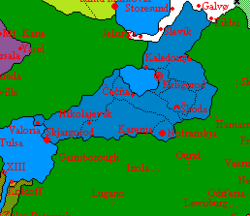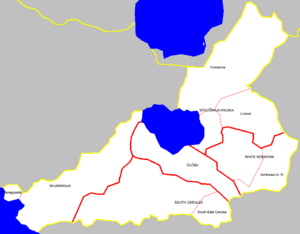Cerulea: Difference between revisions
No edit summary |
|||
| Line 62: | Line 62: | ||
!Function | !Function | ||
|- | |- | ||
|Commissariat for Foreign Affairs | |[[Foreign relations of Cerulea|Commissariat for Foreign Affairs]] | ||
| [[Nada Lesjak]] | | [[Nada Lesjak]] | ||
|Handles all issues relating to diplomacy, diplomatic missions and foreign relations with other nations | |Handles all issues relating to diplomacy, diplomatic missions and foreign relations with other nations | ||
Revision as of 08:52, 2 July 2023
| Union of the Soviet Socialist Republics of Cerulea | |||
| |||
| Motto: Workers of Micras, Unite! | |||
| Anthem: | |||

| |||
| Map versions | |||
| Capital | Krlsgorod | ||
| Largest city | Krlsgorod | ||
| Official language(s) | Cerulean | ||
| Official religion(s) | Cerulean Orthodoxy | ||
| Demonym | Cerulean | ||
| - Adjective | Cerulean | ||
| Government | Soviet Socialist Union | ||
| - First Chairman of the Presidium | Konstantin Fyodorovich Zevyagin | ||
| - Premier of the Supreme Soviet | Vladimir Volodin | ||
| - Legislature | The All-Union Supreme Soviet | ||
| Establishment | |||
| Area | |||
| Population | 17,387,149 | ||
| Active population | 1 | ||
| Currency | Rubl | ||
| Calendar | Norton calendar | ||
| Time zone(s) | |||
| Mains electricity | 120/240 V - 60 Hz | ||
| Driving side | Right | ||
| Track gauge | |||
| National website | |||
| National forum | |||
| National animal | |||
| National food | White Borsch | ||
| National drink | Vodka | ||
| National tree | |||
| Abbreviation | СССРК (SSSRK); USSRC; CE | ||
The Union of the Soviet Socialist Republics of Cerulea (Cerulean Simplified Cyrillic: Союз Советских Социалистических Республик Крлска; Krlski Common Script: Sojuz Sovetskih Socialističeskih Respublik Krlska; USSRC/СССРК, IPA [ kjərl'skə ] or [ ˈkr̩l.skə ]) is a soviet socialist nation in central northern Keltia, descending from the old Kingdom of Cerulea - itself once a part of the Nordic Union (a successor state of Normark) after its government had collapsed due to civil war.
History
The USSRC began as socialist movements spread throughout the The Green in and around the old Cerulean cities, most notably the former capital of Krlsgorod. For the most part, almost all were ethnic Cerulean and existing routes of travel and communication existed between the former Cerulean cities - even some basic infrastructure had been left over from the days of the Nordic Union. t
For years since the dissolution of the Nordic Union, collectivization and socialization of land and resources was the norm amongst the Cerulean people as a means to survive - a method which had proven to be very successful for surviving in the Green's harsh conditions. Over time, the All-Union Communist Party of Cerulea emerged as a dominant unifying power among the various collectives. In 1709 AN, a formal union of the collectives spread throughout the various old territories of Cerulea, to be reorganized as Peoples' Republics, became the USSRC. Three autonomous republics, which chose the CPC as their governing party, also chose to join the Union. They represent ethnic bastions within the USSRC as they comprise of refugees which had come to the region during the time of the Nordic Union but had conglomerated into relatively ethnically homogenous collectives. This includes Ashkenazis from Benecia, Livlanders from along the shores of the Strait of Haifa and the Beregozerians along Lake Morovia from Vizia
The five primary collectives which now constitute major cities of the Union are Krlsgorod, Škoda, Karenja, Skjarsgorod and Čečňa, all also serving as the capitals of the five current republics of the Union, the People's Republic of Stoličnaja Krlska, the People's Republic of the White Mountain, the People's Republic of Southern Cerulea, the People's Republic of Skjarskaja and the People's Republic of Čečňa.
In 1720, following socialist (alliance of social democrats, communists, and Umraists) defeat in the civil conflict in Hurmu, some socialists and Umraists found refuge in Cerulea, among the famous of these, the deposed prime minister Annika Raudsepp (SDP), minister for local government Muhammad Abdullah (HUHU), and Nada Lesjak (SDP), who were immediately naturalized in Cerulea and granted membership in the All-Union Communist Party of Cerulea.
Many vestiges of the union with Normark have been destroyed during the time which Cerulea had descended into the Green, with Ceruleans having grown to regard Normark's influence over Cerulea as an imperialist occupation. As of 1721 AN, Cerulea does not maintain relations with the successor of the Nordic Union, the Kingdom of Normark despite having a border with them. Regardless, the USSRC maintains ties with another Nordic nation, Ostland.
Government
The Legislature
The Supreme Soviet, formally The All-Union Supreme Soviet of Cerulea (Cerulean: Всесоюзный Верховный Совет Крлска) is a bicameral legislature and is the sole governing body of the Union. All members of the legislature are, by law, members of the All-Union Communist Party of Cerulea.
The Congress of the Supreme Soviet
The Congress of the Supreme Soviet is lower house of the legislature. All members of the congress are democratically elected from the various KOMIZOK districts of the Union by the citizens and serve terms of four years. These districts are organized in blocs to make up the individual Republics to be represented in the Congress. In the unlikely event that a tie in voting is reached, the Premier of the Supreme Soviet casts a final deciding vote.
The Presidium of the Supreme Soviet
The Presidium is the upper house of the Supreme Soviet. There are approximately 10 members of the Presidium, all elected from members of the Congress by vote. Those members elected to the Presidium serve terms of eight years. Once all members of the Presidium are elected, the Presidium itself holds a vote to elect the First Chairman of the Presidium, the effective head of state of the Union. The Presidium has the unique distinction of appointing a member of the Congress of the Supreme Soviet the Premier of the Supreme Soviet, which in turn is the effective head of the government of the Union.
Ministerial Agencies
Ministerial agencies in the USSRC - known as Commissariats - exist on an ad hoc basis, being created, abolished or reorganized as needed by the Presidium. Several, however, are de facto permanently established, serving necessary top-level government functions. Each Commissariat is headed by a Commissar, all of whom which make of the People's Executive Council. Each Commissar is nominated by the Congress of the Supreme Soviet and confirmed by the Presidium by simple majority - all serving at the leisure of the Presidium. The People's Executive Council is administered by the First Chairman of the Presidium.
| Commissariat | Commisar | Function |
|---|---|---|
| Commissariat for Foreign Affairs | Nada Lesjak | Handles all issues relating to diplomacy, diplomatic missions and foreign relations with other nations |
| Commissariat for State Security | Handles all issues relating to the preserving of the peoples' harmony within the union, mitigation of foreign and domestic threats and the gathering of intelligence relevant to the aforementioned. | |
| Commissariat for National Defense | Handles all issues dealing with the Peoples' Army, Navy and Airforce, the gathering of applicable intelligence and all fiscal matters pertaining to them. | |
| Commissariat for National Commerce | Handles all issues dealing with the primary goal of the prosperity of the people in regard to the regulation of the manufacturing, trade, sale and exchanging of goods and services within the nation in accordance with the values of the CPC. | |
| Commissariat for the Interior | Handles all issues regarding infrastructure, education and collectivization. |
| Commissariat | Commissar | Function |
|---|---|---|
| Commissariat for National Sportsmanship | Handles all issues regarding professional, semi-professional, collegiate and amateur sporting activities. | |
| Commissariat for Energy Production | Handles all specialized issues regarding the production of useful electrical energy not directly under
the jurisdiction of the Commissariat for the Interior. | |
| Commissariat for Higher Education | Handles all specialized issues relating only to institutions of higher learning such as colleges, technical schools and
universities, providing such assistance as needed to the Commissariat for the Interior. |
Union & Autonomous Republics
The USSRC, as of 1721 AN, consists of five Republics with each one governed by a democratically elected executive known as a Premier. As they are the peoples' executive for their Republic, they do not partake in voting in the legislature but serve as the head of any local republic legislatures.
An autonomous republic forms an autonomous part of an established union republic.
| Flag | Republic | Capital | Premier | Autonomous republic(s) |
|---|---|---|---|---|
| People's Republic of Stoličnaja Krlska | Krlsgorod | Livland | ||
| Caledonia | ||||
| People's Republic of South Cerulea | Karenja | South-East Cerulea | ||
| People's Republic of the White Mountain | Škoda | Ashkenazi APR | ||
| People's Republic of Skjarskaja | Skjargorod | Beregozeria | ||
| People's Republic of Čečňa | Čečňa | – |
Sports
Cerulea's primary sport is hockey, governed by the Cerulean National League.


